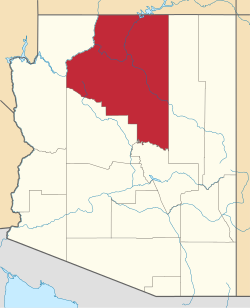History
The town was founded around 1899 and was initially called Anita Junction. [3]
The railroad was originally built to serve the Anita mines, just under three miles away on what became a spur of the line to Grand Canyon. The mines turned out to be worth little, which led to the continuation of the line to the canyon to serve tourists. [4]
At its peak, Anita contained a school, post office, telephone, and the headquarters of the Anita-Moqui forest service district. It also had several railroad sidings. [3]
The Anita section of the railroad was closed in 1942. By 1956, no structures remained at the site. [3]
The school at Anita, along with the neighboring one at the lumber town of Apex, were at one time the only racially integrated schools in Arizona. [5]
This page is based on this
Wikipedia article Text is available under the
CC BY-SA 4.0 license; additional terms may apply.
Images, videos and audio are available under their respective licenses.


